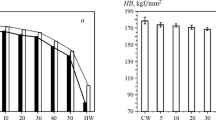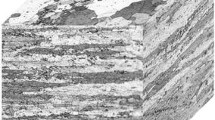Abstract
In this study, the cooling behavior of Sr-modified A356 alloy aluminum wheels produced by low-pressure die-casting technology was investigated in different quenching mediums. Water and surfactant quenchants were used in order to determine the cooling rate and mechanical properties of the alloy. A thermocouple was attached to the wheels, and parts were immersed into different quenching mediums after solution treatment. Data were collected by using a data logger. Tensile test and hardness test were carried out in order to determine the effect of quenching step on mechanical properties. Statistical analysis was performed, and graphics were drawn with Minitab. Maximum cooling rates throughout the quenching were obtained, respectively, 61–68–70–85 °C/s at SDS, Triton X-100, Tween 20 and water quenching medium. It was found that 61 °C/s is enough to suppress precipitation for artificially aging, and the cooling rate at Leidenfrost point is the most important parameter for correlation with mechanical properties. According to the hypothesis analysis, only yield strength values were affected by the quenching rate at LDP statistically.












Similar content being viewed by others
References
C.R. Brooks, Heat treating of aluminum alloys, in ASM Handbook, Heat Treating, vol. 4, ed. by S.M. Copley (ASM International, Materials Park, 1991), pp. 1861–1867
S. Kuntongnum, S. Wısutmethangoon, T. Plookphol, J. Wannasın, Influence of heat treatment processing parameters on the hardness and the microstructure of semi-solid aluminum alloy A356. J. Met. Mater. Miner. 18(2), 93–97 (2008)
M. Maniruzzaman, M. Fontecchio, R.D. Sisson, The effect of agitation and quenchant temperature on the heat transfer coefficients for 6061 aluminum alloy quenched in distilled water, in Quenching and Cooling, Residual Stress and Distortion Control, ed. by L.C.F. Canale, M. Narazaki (ASTM International, Bridgeport, 2009), pp. 104–113
H. Möller, G. Govender, W.E. Stumpf, Application of shortened heat treatment cycles on A356 automotive brake calipers with respective globular and dendritic microstructures. Trans. Nonferrous Met. Soc. China 20, 1780–1785 (2010)
S.S. Sahay, G. Mohapatra, G.E. Totten, Overview of pearlitic rail steel: accelerated cooling, quenching, microstructure, and mechanical properties, in Quenching and Cooling, Residual Stress and Distortion Control, ed. by L.C.F. Canale, M. Narazaki (ASTM International, Bridgeport, 2009), pp. 692–727
C.K. Huang, V.P. Carey, The effects of dissolved salt on the Leidenfrost transition. Int. J. Heat Mass Transf. 50, 269–282 (2007)
A.M.A. Mohamed, F.H. Samuel, A review on the heat treatment of Al–Si–Cu/Mg casting alloys, in Heat Treatment—Conventional and Novel Applications, ed. by F. Czerwinski (InTech, Rijeka, 2012). https://doi.org/10.5772/50282
B. Milkereit, H. Fröck, C. Schick, O. Kessler, Continuous Cooling Precipitation Diagram of Cast Aluminium Alloy Al–7Si–0.3Mg. Trans. Nonferrous Met. Soc. China 24, 2025–2033 (2014)
B. Liscic, H.M. Tensi, L.C.F. Canale, G.E. Totten (eds.), Quenching Theory and Technology, 2nd edn. (Taylor and Francis Group LLC., Broken Sound Parkway, 2010)
U. Alam, Experimental study of local heat transfer during quenching of metals by spray and multiple jets. Ph.D. Thesis, Universität Magdeburg, Magdeburg (2011)
J. Manickaraj, G. Liu, S. Shankar, Effect of incubation coupled with artificial aging in T6 heat treatment of A356.2 aluminium casting alloy. Int. J. Metalcast. 5, 17–36 (2011)
E. Lee, B. Mishra, Effect of cooling rate on the mechanical properties of AA365 aluminium alloy heat-treated under T4, T5, and T6 conditions. Int. J. Heat Mass Transf. 12, 449–456 (2017)
S.G. Shabestari, F. Shahri, Influence of modification, solidification conditions and heat treatment on the microstructure and mechanical properties of A356 aluminum alloy. J. Mater. Sci. 39, 2023–2032 (2004)
D.A. Lados, D. Apelian, Solution treatment effects on microstructure and mechanical properties of Al–(1 to 13pct)Si–Mg cast alloys. Metall. Mater. Trans. B Process Metall. Mater. Process. Sci. 42(1), 171–180 (2011)
J. Pezda, A. Jarco, Effect of T6 heat treatment parameters on technological quality of the AlSi7Mg alloy. Arch. Foundry Eng. 16, 95–100 (2016)
Acknowledgements
This research study was carried out in cooperation with Dokuz Eylul University, The Graduate School of Natural and Applied Sciences, Dokuz Eylul University Metallurgical and Materials Engineering and CMS Jant ve Makina Sanayi A.Ş. R&D Department. The authors would like to thank Bora Yay for his support.
Author information
Authors and Affiliations
Corresponding author
Additional information
Publisher's Note
Springer Nature remains neutral with regard to jurisdictional claims in published maps and institutional affiliations.
Rights and permissions
About this article
Cite this article
Güneren, A., Dokumacı, E. Cooling Behavior of A356 Alloy in Surfactant Quenching Medium. Inter Metalcast 14, 580–588 (2020). https://doi.org/10.1007/s40962-019-00386-1
Published:
Issue Date:
DOI: https://doi.org/10.1007/s40962-019-00386-1




